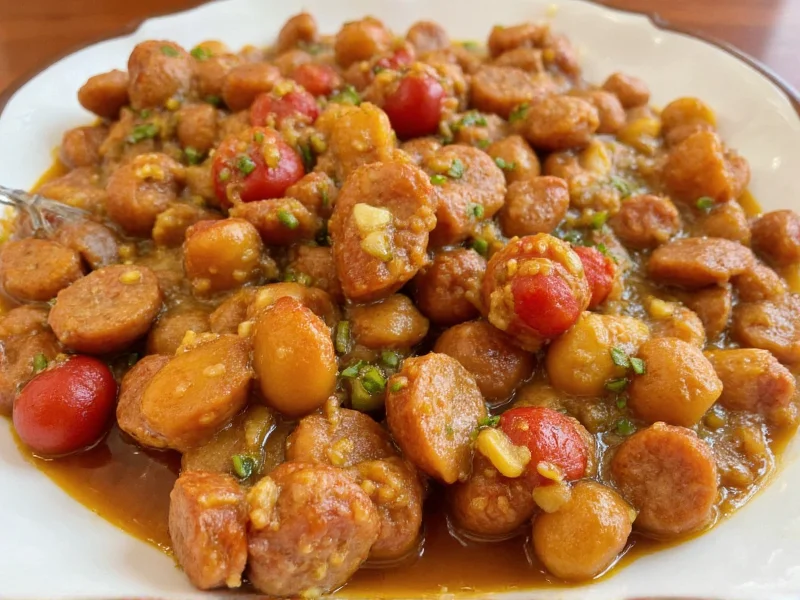Sausage dressing represents one of America's most beloved comfort foods, particularly cherished during holiday seasons. Unlike its cousin stuffing, which is traditionally cooked inside poultry, dressing is baked separately in a casserole dish. This preparation method allows for better texture control and food safety, as the dressing reaches proper internal temperatures without overcooking the bird.
Understanding Sausage Dressing Variations
The term "dressing" versus "stuffing" often causes confusion. In culinary terms, the distinction primarily relates to preparation method rather than ingredients. What makes sausage dressing unique is the incorporation of ground pork sausage, which transforms ordinary bread dressing into a rich, flavorful accompaniment. Southern sausage dressing recipes typically feature cornbread as the bread component, while Northern variations might use white or sourdough bread.
| Regional Variation | Key Characteristics | Signature Ingredients |
|---|---|---|
| Traditional Southern | Cornbread-based, moist texture | Cornbread, sage, celery, onion, pork sausage |
| Midwestern | White bread foundation, herb-forward | White bread, poultry seasoning, applewood sausage |
| Cajun/Creole | Spicy, complex flavor profile | Cornbread, andouille sausage, bell peppers, cayenne |
| Modern Vegetarian | Meat-free alternative | Mushrooms, plant-based sausage, vegetable broth |
Essential Components of Perfect Sausage Dressing
Creating exceptional sausage dressing requires attention to each component. The bread element serves as the structural foundation—stale bread works best as it absorbs liquid without becoming mushy. Many home cooks prepare cornbread specifically for dressing several days in advance. The sausage selection dramatically impacts flavor; mild breakfast sausage provides traditional notes, while spicy varieties add complexity. High-quality sausage with visible meat content (rather than fillers) yields superior results.
Liquid components balance moisture levels. Chicken or turkey broth creates classic flavor, though some recipes incorporate small amounts of milk or cream for richness. The vegetable trio of onions, celery, and bell peppers (known as "holy trinity" in Southern cooking) builds aromatic depth. Herbs should be fresh when possible—sage remains non-negotiable in traditional recipes, while thyme, rosemary, and parsley offer complementary notes.
Mastering Sausage Dressing Technique
Proper technique separates adequate dressing from exceptional. Start by cooking sausage thoroughly, draining excess fat to prevent greasiness. Sauté vegetables until softened but not browned to maintain brightness. Combine ingredients gently—overmixing compacts the dressing, resulting in dense texture. The ideal moisture level resembles a damp sponge: when squeezed, it holds shape briefly before crumbling.
Baking temperature and duration prove critical. Most recipes require 350°F (175°C) for 45-60 minutes. The dressing should develop a golden crust while remaining moist inside. Inserting a thermometer into the center should register 165°F (74°C) for food safety. Allowing dressing to rest 10-15 minutes after baking lets flavors meld and texture stabilize.
Avoiding Common Sausage Dressing Mistakes
Even experienced cooks encounter pitfalls with sausage dressing. The most frequent error involves improper bread-to-liquid ratio. Too little liquid creates dry, crumbly dressing; too much yields mushiness. Another issue stems from inadequate sausage cooking—undercooked sausage poses safety risks, while overcooked sausage becomes tough. Seasoning mistakes often occur when adding salt; remember that sausage and broth already contain sodium.
Texture problems frequently arise from bread selection. Fresh bread disintegrates, while overly stale bread won't absorb flavors properly. For optimal results, use bread dried overnight at room temperature. When incorporating eggs (in some recipes), beat them thoroughly before mixing to ensure even distribution without overworking the mixture.
Serving Suggestions and Creative Variations
While traditionally served alongside roast turkey, sausage dressing pairs beautifully with numerous proteins. It complements roasted chicken, pork loin, or even serves as a standalone vegetarian meal when prepared without meat. Leftover dressing transforms into next-day breakfast hash when pan-fried with additional vegetables.
Creative adaptations include adding dried fruits like cranberries or apples for sweetness contrast, incorporating nuts for texture, or mixing in cheese for richness. For gluten-free versions, cornbread made from certified gluten-free mix works well. Some cooks enhance flavor by cooking sausage with aromatics like fennel or apple before crumbling it into the dressing mixture.
Food Safety Considerations for Sausage Dressing
Proper food handling proves essential when preparing sausage dressing. Always cook sausage to 160°F (71°C) internal temperature before incorporating into dressing. When using as poultry stuffing, ensure both bird and stuffing reach safe temperatures—this often requires separate cooking for safety. Refrigerate leftovers within two hours, and consume within four days. When reheating, bring internal temperature to 165°F (74°C).
Perfecting Your Sausage Dressing Recipe
Refining your personal sausage dressing recipe involves thoughtful adjustments. Start with a reliable base recipe, then experiment with incremental changes. Try different sausage varieties—maple-flavored, apple sage, or hot Italian each create distinct profiles. Adjust herb ratios to preference, remembering that dried herbs require less quantity than fresh. For holiday meal planning, prepare components in advance: cook and crumble sausage, chop vegetables, and dry bread several days before assembly.











 浙公网安备
33010002000092号
浙公网安备
33010002000092号 浙B2-20120091-4
浙B2-20120091-4